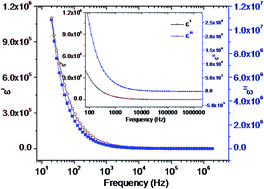A new single/few-layered graphene oxide with a high dielectric constant of 106: contribution of defects and functional groups†
Abstract
In this study, we introduce a single/few-layered graphene oxide (GO) synthesized with ultrasonication, and demonstrate its high dielectric permittivity in the frequency range of 20 Hz to 2 MHz and temperature range of 30 °C to 180 °C. A high dielectric constant of GO (∼106) with low loss was observed at 1 kHz and at 30 °C, which is even very high compared to conventional dielectric materials such as CaCu3Ti4O12. The conductivity of our GO was calculated and found to be 3.980 × 10−5 to 1.943 × 10−5 (DC) and 2.0 × 10−3 to 1.7 × 10−2 (AC). The various conducting mechanisms governing the conductivity (AC and DC) of GO with varying frequency and temperature are assessed using impedance spectroscopy. The mechanistic approach and the role of functional groups, defects, temperature and frequency are elucidated and discussed with regard to the high dielectric constant. The variation of activation energy from 1.15 (1 kHz) to 0.58 (2.0 MHz) is related to the frequency dependent conductivity of the π–π conjugated electrons and their hopping has also been discussed. The present dielectric results are superior to those of GOL (with fewer defects/less sonication time). Moreover, the present findings suggest that the new GO can be used for scaling advances high performance electronic devices and high dielectric-based electronic and energy storage devices.


 Please wait while we load your content...
Please wait while we load your content...